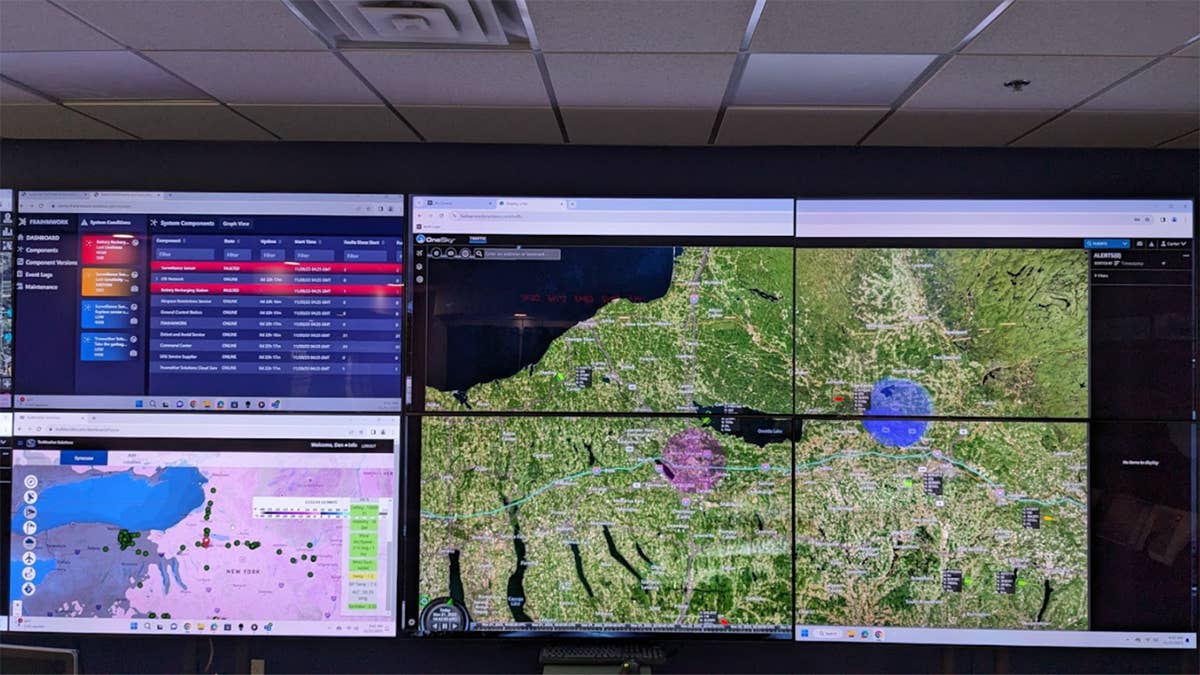NASA, Air Force, and ResilienX Partner to Build AAM Operations Center
The center is expected to open for government and commercial use in late 2024, beginning with a single site at Syracuse Hancock International Airport (KSYR).

AFWERX and NASA are partnering to build an advanced air mobility (AAM) digital operations center. [Courtesy: Andrew Carter/U.S. Air Force]
Two U.S. agencies working to usher in the era of advanced air mobility (AAM) are stepping up their partnership.
AFWERX, the innovation arm of the U.S. Air Force, is collaborating with NASA to develop a digital operations center for AAM services, such as electric air taxis, nationwide. The project follows a partnership agreed on by AFWERX and the FAA in June to exchange flight test data and testing capabilities for emerging aircraft designs, such as electric vertical takeoff and landing (eVTOL).
To establish the center, AFWERX and NASA have enlisted ResilienX, a producer of safety software for uncrewed aerial system (UAS) traffic management, or UTM. The company is an awardee of NASA’s Civilian Commercialization Readiness Pilot Program (CCRPP), which funds emerging technologies through Small Business Innovation Research and Small Business Technology Transfer contracts as a way to speed commercialization.
“CCRPP is a true example of public-private partnership where government stakeholders and an industry consortium are working together on the airspace efforts,” said Darshan Divakaran, AFWERX Airspace Innovation and Prime Partnerships program manager.
So far, not much is known about the project’s inner workings. But according to this week’s announcement, the system is intended to improve base security, special forces efforts, emergency disaster response, and passenger and cargo transportation planning. Future developments will allow it to loop in “other technologies necessary for air domain awareness.”
ResilienX will lead an industry consortium tasked with designing the digital system. Its goal will be to integrate an AAM operations center that is both scalable and tactical, capable of verifying all of the systems and sensors that go into UAS, eVTOL, and other emerging aircraft designs.
Through the CCRPP, ResilienX received $4.8 million in funding for the program from AFWERX and NASA. It will be contracted through 2025.
“We are thrilled with the trust AFWERX has put in us to lead this consortium,” said Ryan Pleskach, CEO of ResilienX. “Through a dedicated systems engineering approach, we intend to develop a dual-use solution to the core digital infrastructure needed for AAM that is inherently scalable and extensible…We believe this solution will be turnkey and available to government and commercial markets in late 2024.”
The initial center will be built in partnership with New York’s Northeast UAS Airspace Integration Research (NUAIR) organization at Syracuse Hancock International Airport (KSYR). The partners plan to test and transition it to other locations by 2025.
The first phase of development will require testing, integration of baseline technologies, detailed need and task assessment, and feature development through user interviews and observations. The second phase will comprise user testing, prototype testing, live system demonstrations, and safety development. AFWERX intends to bring in more industry partners to assist with the latter.
“[AFWERX] Agility Prime helped pave the way for government and industry to work together on aircraft certification,” said Divakaran. “The Airspace Innovation team is taking it a step forward with airspace integration, management and security efforts focused on emerging aviation technologies.”
AFWERX and NASA’s collaboration will be a welcome development for the emerging AAM industry, which has yet to take flight.
Initial air taxi services are currently targeted to launch as soon as 2025, while a handful of personal eVTOL companies expect to begin deliveries around that year—or sooner. But before that happens, the aircraft will need to be type certified (so far, only China’s EHang holds that distinction) and the infrastructure will need to be in place.
AFWERX and NASA have both made AAM a priority. Each works individually with industry players and other federal agencies to integrate new aviation technologies into the national airspace.
Through various contracts and agreements, AFWERX works with some of the eVTOL industry’s biggest players to test and mature their aircraft. Joby Aviation, Archer Aviation, Beta Technologies, Pipistrel, and Jump Aero are just a few of the firms under contract. Already, two of them, Joby and Beta, have delivered their first eVOL aircraft to military bases. NASA is involved in a few AFWERX projects as well.
Separately, the space regulator works with manufacturers such as Overair, Electra.aero, and Hyundai’s Supernal through projects such as the AAM National Campaign, which seeks to leverage partnerships to speed safe integration. NASA also leads other AAM initiatives, such as the Pathfinders Project or AAM Playbook.
Additionally, both NASA and AFWERX are part of the Department of Transportation’s AAM Interagency Working Group (AAMIWG), which was established in May to coordinate federal integration efforts.
The agencies’ new collaboration comes just over a month after AFWERX agreed to join forces with the FAA on AAM testing and safe integration. They’ll share data and expertise to prepare airports, pilots, policies, and other aircraft for the emergence of electric air taxis and other advanced aircraft. According to the partners, the arrangement is geared toward the development of U.S.-made aircraft, in particular.
AFWERX, NASA, the FAA, and other agencies are working under a 2028 deadline established by the FAA’s Innovate28 plan for AAM operations at scale. The plan sets targets and priorities for the first wave of AAM services, but it does not establish any permanent rules or regulations.
Like this story? We think you'll also like the Future of FLYING newsletter sent every Thursday afternoon. Sign up now.

Subscribe to Our Newsletter
Get the latest FLYING stories delivered directly to your inbox






